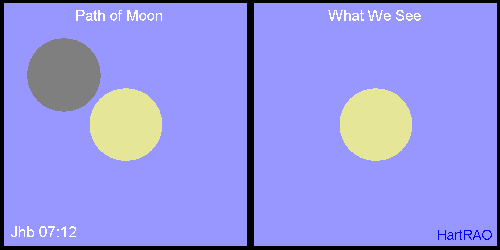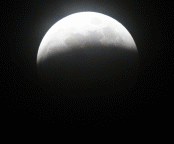Difference between revisions of "Lunar Eclipse due to Shadow Object"
Tom Bishop (talk | contribs) (Separating out the two different explanations for the Lunar Eclipse) |
PeteSvarrior (talk | contribs) m (Reverted edits by 107.167.244.83 (talk) to last revision by Tom Bishop) Tag: Rollback |
||
| (6 intermediate revisions by 2 users not shown) | |||
| Line 7: | Line 7: | ||
The shadow object is never seen in the sky because it orbits the sun on the ''day'' side of the earth, in the large vicinity where celestial bodies are invisible. As the sun's powerful vertical rays hit the atmosphere during the day they will scatter and blot out nearly every single star and celestial body in the daytime sky. We are never given a glimpse of the celestial bodies which appear near the sun during the day - they are completely washed out by the sun's light. In fact, when the daytime Moon gets too close to the sun's vicinity it will completely disappear from sight. Except for during the time of Solar Eclipse, the Moon is only seen during the day at a far opposite side of the sky from the sun. | The shadow object is never seen in the sky because it orbits the sun on the ''day'' side of the earth, in the large vicinity where celestial bodies are invisible. As the sun's powerful vertical rays hit the atmosphere during the day they will scatter and blot out nearly every single star and celestial body in the daytime sky. We are never given a glimpse of the celestial bodies which appear near the sun during the day - they are completely washed out by the sun's light. In fact, when the daytime Moon gets too close to the sun's vicinity it will completely disappear from sight. Except for during the time of Solar Eclipse, the Moon is only seen during the day at a far opposite side of the sky from the sun. | ||
| − | + | There is also a possibility that the Shadow Object is a ''known'' celestial body which orbits the sun, and which projects an enlarged shadow upon the moon larger than the source body, like the enlarged shadows on the wall during a shadow puppet show; but more study would be needed to track the positions of Mercury, Venus and the sun's asteroid satellites and correlate them with the equations for the lunar eclipse before any conclusion could be drawn. | |
| − | |||
| − | There is also a possibility that the Shadow Object is a ''known'' celestial body which orbits the sun, and which projects | ||
==Celestial Bodies Not Visible== | ==Celestial Bodies Not Visible== | ||
| Line 21: | Line 19: | ||
==Ancient and Modern Astronomers== | ==Ancient and Modern Astronomers== | ||
| − | The reason the ancient societies such as the Greeks and Babylonians were able to predict the Lunar Eclipses was because the predictions are based on recurring charts and tables of past eclipses. Modern Astronomers still use the same pattern prediction methods. It had | + | The reason the ancient societies such as the Greeks and Babylonians were able to predict the Lunar Eclipses was because the predictions are based on recurring charts and tables of past eclipses. Modern Astronomers still use the same pattern prediction methods. It had little to do with the shape of the earth or the actual geometry of the system. The Lunar Eclipse is a phenomenon which comes in patterns. By studying these patterns it is possible to predict when the next transit or eclipse will occur. The astronomer can use historic charts and tables with a few equations to predict the time, magnitude, and duration of a future eclipse. |
This does not apply only to the eclipse, either: All recurring phenomena such as the transits of planets, occultations of bodies, and precision of paths across the sky are predicable only because they are phenomena which come in patterns. Astronomers predict celestial events by studying the patterns and predicting when the next occurrence will occur. | This does not apply only to the eclipse, either: All recurring phenomena such as the transits of planets, occultations of bodies, and precision of paths across the sky are predicable only because they are phenomena which come in patterns. Astronomers predict celestial events by studying the patterns and predicting when the next occurrence will occur. | ||
| Line 37: | Line 35: | ||
==Why the Lunar Eclipse is Red== | ==Why the Lunar Eclipse is Red== | ||
| − | One explanation | + | One explanation for why the Lunar Eclipse is red is because the light of the sun is shining through the body of the Shadow Object which passes between the Sun and Moon during a Lunar Eclipse. The red tint occurs because the Shadow Object is not sufficiently dense. The Sun's light is powerful enough to shine through the Shadow Object, just as a flashlight is powerful enough to shine through your hand when you put it right up against your palm. |
[[File:2007-03-03 - Lunar Eclipse small-43img.gif|350x]] | [[File:2007-03-03 - Lunar Eclipse small-43img.gif|350x]] | ||
Latest revision as of 17:23, 15 October 2022
A Lunar Eclipse occurs about twice a year when a satellite of the sun passes between the sun and moon.
This satellite is called the Shadow Object or Antimoon. Its orbital plane is tilted at an angle to the sun's orbital plane, making eclipses possible only when the three bodies (Sun, Object, and Moon) are aligned. Within a given year a maximum of three lunar eclipses can occur. Despite the fact that there are more solar than lunar eclipses each year, over time many more lunar eclipses are seen at any single location on earth than solar eclipses. This occurs because a lunar eclipse can be seen from the entire half of the earth beneath the moon at that time, while a solar eclipse is visible only along a narrow path on the earth's surface.
Total lunar eclipses come in clusters. There can be two or three during a period of a year or a year and a half, followed by a lull of two or three years before another round begins. When you add partial eclipses there can be three in a calendar year and again, it's quite possible to have none at all.
The shadow object is never seen in the sky because it orbits the sun on the day side of the earth, in the large vicinity where celestial bodies are invisible. As the sun's powerful vertical rays hit the atmosphere during the day they will scatter and blot out nearly every single star and celestial body in the daytime sky. We are never given a glimpse of the celestial bodies which appear near the sun during the day - they are completely washed out by the sun's light. In fact, when the daytime Moon gets too close to the sun's vicinity it will completely disappear from sight. Except for during the time of Solar Eclipse, the Moon is only seen during the day at a far opposite side of the sky from the sun.
There is also a possibility that the Shadow Object is a known celestial body which orbits the sun, and which projects an enlarged shadow upon the moon larger than the source body, like the enlarged shadows on the wall during a shadow puppet show; but more study would be needed to track the positions of Mercury, Venus and the sun's asteroid satellites and correlate them with the equations for the lunar eclipse before any conclusion could be drawn.
Celestial Bodies Not Visible
During the day the celestial bodies near the sun are invisible. An example of this is seen in the appearance of the Moon during the Solar Eclipse. The Moon seems to appear out of nowhere to intersect the Sun.
Another example of the sky-colored moon is seen in the timeanddate.com Solar Eclipse simulations.
Ancient and Modern Astronomers
The reason the ancient societies such as the Greeks and Babylonians were able to predict the Lunar Eclipses was because the predictions are based on recurring charts and tables of past eclipses. Modern Astronomers still use the same pattern prediction methods. It had little to do with the shape of the earth or the actual geometry of the system. The Lunar Eclipse is a phenomenon which comes in patterns. By studying these patterns it is possible to predict when the next transit or eclipse will occur. The astronomer can use historic charts and tables with a few equations to predict the time, magnitude, and duration of a future eclipse.
This does not apply only to the eclipse, either: All recurring phenomena such as the transits of planets, occultations of bodies, and precision of paths across the sky are predicable only because they are phenomena which come in patterns. Astronomers predict celestial events by studying the patterns and predicting when the next occurrence will occur.
See: Astronomical Prediction Based on Patterns
Modern Eclipse Models
Q. But what about NASA's yearly lunar eclipse predictions? They must be based on a geometric model, and not simply cycles in the sky, surely?
A. NASA freely admits that they use ancient cycle charts for their eclipse predictions. The Saros Cycle and those cobby old ancient methods which simply look at past patterns in the sky to predict the next one is precisely how "modern theorists" predict the lunar eclipse today.
See: Astronomical Prediction Based on Patterns - The Eclipses
Why the Lunar Eclipse is Red
One explanation for why the Lunar Eclipse is red is because the light of the sun is shining through the body of the Shadow Object which passes between the Sun and Moon during a Lunar Eclipse. The red tint occurs because the Shadow Object is not sufficiently dense. The Sun's light is powerful enough to shine through the Shadow Object, just as a flashlight is powerful enough to shine through your hand when you put it right up against your palm.


